The OnePlus 3 Review
by Brandon Chester on June 20, 2016 8:00 AM EST- Posted in
- Smartphones
- OnePlus
- OnePlus 3
Display
Update: OnePlus has since addressed the issues with calibration. Click here for my follow-up article.
One of the most disappointing aspects of the OnePlus 2 was its display. Like the OnePlus One it was a 5.5” IPS LCD display, but the similarities ended there. The OnePlus One shipped with a very well calibrated display, and at the time that wasn’t something you could always expect from devices priced around $300. With the OnePlus 2 the display got a much appreciated boost in peak brightness, but the color accuracy regressed severely. The display was heavily blue shifted, and to say that it tied the Nexus 6 as the most inaccurate display tested in recent years would actually be generous. With how good the display on the OnePlus One was, the OnePlus 2 was a huge letdown.
The OnePlus 3 is a chance for OnePlus to fix the mistakes they made with the OnePlus 2. Like the past two OnePlus flagship devices, we’re still talking about a 5.5” display. However, OnePlus has moved to an AMOLED panel. OnePlus calls this an Optic AMOLED display, although they don’t go into much detail on what that means, beyond claiming that the display uses “Custom-engineered gamma corrections that help create a more natural viewing experience”. It’s generally not a good sign when the description of a technology is very vague and just throws in some technical jargon instead of quantifying and explaining what is actually going on. OnePlus also claims that the display “produces colors that are more vivid and true-to-life than other AMOLED displays”, which sounds like good news given how accurate the AMOLED displays on other smartphones already are.
Before covering display accuracy, I want to comment on OnePlus's use of a 1080p AMOLED panel. According to comments made by OnePlus, a 1080p display was chosen as it provides superior battery life, and because resolutions above 1080p are not useful outside of VR. I have to respectfully disagree with both points, especially because this is a PenTile AMOLED display. It has been well demonstrated that good battery life is achievable not just with 1440p AMOLED smartphones, but with 1440p LCD smartphones. While I do feel 1080p is a good resolution to choose for a 5.5" RGB LCD panel, it is simply not adequate for a PenTile AMOLED display.
When you consider the effective resolution of red and blue on the OnePlus 3, you're really dealing with a display that is roughly equivalent to the iPhone 6s in chroma resolution, except on a 5.5" display instead of a 4.7" one. The resolution for green is equivalent to a 1080p display, and subpixel rendering is what allows you to make the claim that it's still a 1080p display, but for everything except pure green your effective resolution is going to be lower. In addition to that, the uneven size and spacing of the subpixels, along with their diamond pattern, makes them less than optimal for rendering the latin alphabet which contains many vertical lines. This kind of screen door effect has long been noticed on PenTile displays, and for the most part the push for 1440p AMOLED panels has mitigated those complaints.
On the OnePlus 3 it's pretty obvious that text is rendered less clearly than the iPhone 6s, which has a pixel density of only 326ppi, well below that of flagship Android devices. With the OnePlus One and OnePlus 2 for comparison it's completely obvious that the OnePlus 3 has a lower effective resolution, with text exhibiting distracting artifacts, and solid patterns that are red, blue, or white having a crosshatch pattern that simply isn't visible on OnePlus's older smartphones. I completely agreed with OnePlus's choice of 1080p on their past smartphones, but saying that there's no benefit to going higher on a PenTile AMOLED display is simply false, and there's no getting around the fact that the OnePlus 3 has a lower effective resolution than its predecessors.
While OnePlus isn't off to a great start with their display resolution, there are many other aspects of a display that need to be considered beyond the number of pixels. To examine the OnePlus 3’s display I’ve run our standard display workflow on it. As always, measurements are performed with an i1Pro 2 spectroradiometer, with the exception of contrast which is done with an i1Display Pro colorimeter. Data is collected and managed with SpectraCal’s CalMAN 5 software.
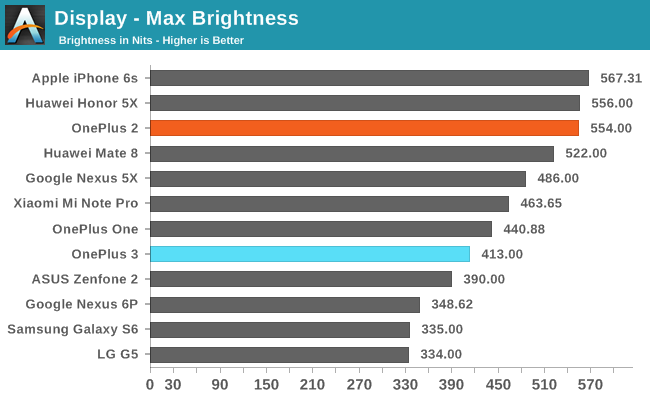
Right out of the gate things are not looking good for the OnePlus 3. Peak brightness only hits 413 nits, which is a huge regression from the OnePlus 2’s 554 nits. The impact that this has on outdoor usability is very significant, with the display being much harder to use in the sun than the OnePlus 2. To make matters worse, there’s no brightness boost mode that activates when you have the auto-brightness on. At this point I really don’t think it’s acceptable to ship a phone that can’t hit 500 nits when you’re in the sun, and Samsung is pushing 600 nits on their AMOLED displays when they boost brightness so OnePlus is well behind the competition.
Given that the OnePlus 3 uses an AMOLED display, you technically have infinite contrast when there’s no ambient light. In practice the OnePlus 3 definitely has better black levels than any LCD device that I own, but the OnePlus 2 still had a great static contrast ratio, and the better blacks weren’t worth sacrificing the 550 nit peak brightness at all.
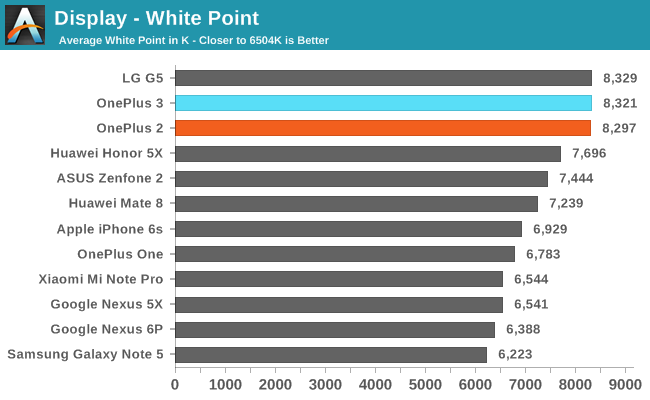
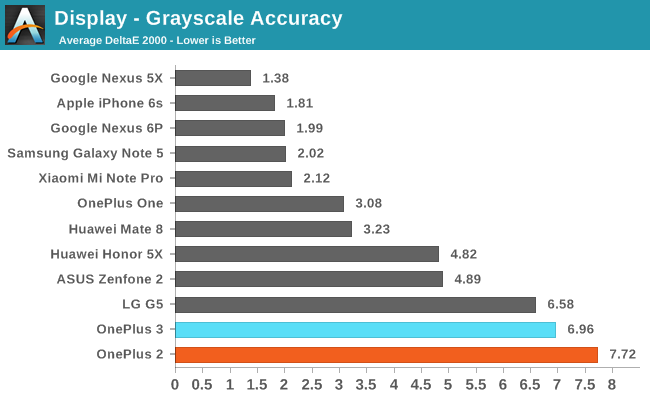
Greyscale accuracy on the OnePlus 3 is very poor. It’s not as bad as the OnePlus 2, but given how severe the errors are, it’s entirely possible that I just happened to get an exceptionally bad OnePlus 2 unit and an exceptionally good OnePlus 3. Whatever the case may be, the OnePlus 3 still has severe issues with greyscale rendition. Gamma is somewhat more accurate than the OnePlus 2 that I received, but the display has even more severe blue shifting, and it’s immediately apparent right from the very first setup screen when you turn on the phone.
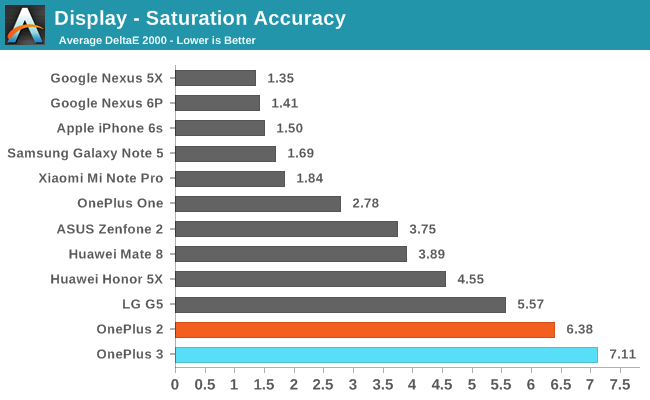
In the saturation sweep test, the OnePlus 3 performs even more poorly than the OnePlus 2. You can tell from the gamut that they’re actually targeting NTSC, which makes me feel like I’ve been sent back in a time machine to 2010 where this was the problem with AMOLED displays on smartphones like the Nexus One and the original Galaxy S. I really thought that we had moved past this, past the point where AMOLED phones would ship with nonsensical gamut targets that you can’t change, but clearly I was wrong.
What I really don’t understand is why the NTSC gamut was chosen as the target. With very old AMOLED phones this was chosen under the mistaken belief that NTSC was the correct gamut to use for displaying videos on smartphones, which was absolutely wrong. The gamut defined in the NTSC standard is over sixty years old, it was never even reproduced properly on the CRT displays of the time because they couldn’t do so with an adequate brightness level, and it was replaced as a “standard” gamut decades ago, basically not ever being used outside the Americas at all. When a smartphone targets Adobe RGB you can at least see the misguided but well-intentioned attempt to give a wider gamut using a color standard that actually is used in some cases, but when NTSC is the target it just shows a severe lack of understanding of modern displays and color standards.
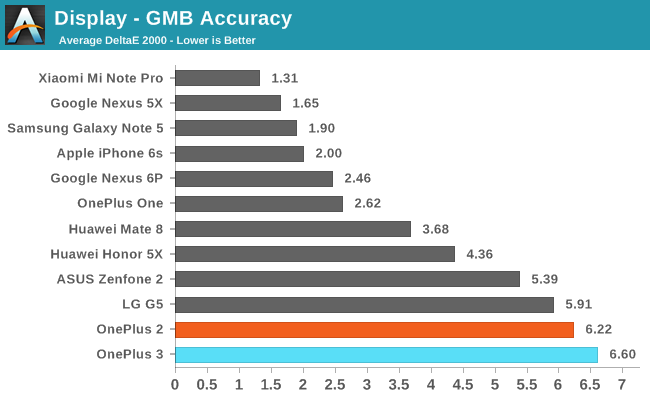
With poor greyscale and color reproduction, there’s absolutely no hope for proper color mixture rendition. As expected, the OnePlus 3 also regresses here, and beats the OnePlus 2 as the most inaccurate display on the chart. I really don’t have anything else to say here, as I’m just so frustrated by OnePlus’s choices here.
It’s evident that OnePlus didn’t learn from the issues I demonstrated with the OnePlus 2’s display. It was a serious regression from the OnePlus One, and with the OnePlus 3 they’ve somehow found a way to regress even further. Of all the aspects of a phone to mess up, the display is the absolute worst. There’s basically no use case where you use a phone without looking at the screen, and right from the very first moment I turned on the OnePlus 3 I could tell that the colors are completely wrong. It’s just a huge disappointment.
There is one glimmer of hope. After reaching out to OnePlus, explaining why the choice of the NTSC color space as a target doesn't make any sense, and showing the errors it causes with sRGB rendition, they told me that they now intend to offer an sRGB mode as an option in an upcoming OTA update. There's no firm timeline for this which makes me uneasy, and I can't make a recommendation based on an update that isn't guaranteed, but it's worth making note of. Unfortunately, I am unsure of whether or not this is something that can be fixed after the phone has already shipped. OnePlus has left the display extremely blue which is often indicative of little or no white point calibration, which would mean it's impossible to tune the phones because you don't even have an idea of what the panel characteristics are. For that reason, I remain hopeful but somewhat skeptical, and I plan to revisit the display of the OnePlus 3 if and when OnePlus adds this feature.
While an sRGB mode may be coming, right now the display accuracy you get on the OnePlus 3 reminds me a great deal of early AMOLED devices from 2010, and that's not a good thing at all. I really expected OnePlus to fix their mistakes from the OnePlus 2 because they did so with so many other aspects of the phone. The only explanation I can think of is that nobody actually understood the negative impact of shipping a wide gamut display on a non-color-managed operating system. This actually seems like the most likely explanation, as the choice of NTSC as the target gamut was definitely not an informed decision. Regardless of what path led to the OnePlus 3's current display, the end result is that the poor display calibration ruins the phone for me, because the screen is just unpleasant to look at. If display accuracy doesn’t matter at all to you it may be possible to overlook it, but for anyone who cares even the slightest bit the issues with the OnePlus 3’s display will be too severe to live with.



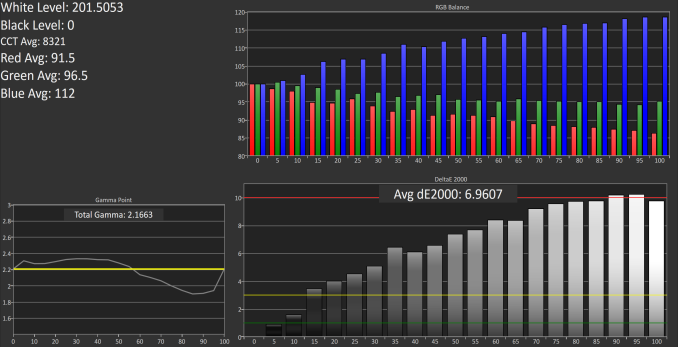

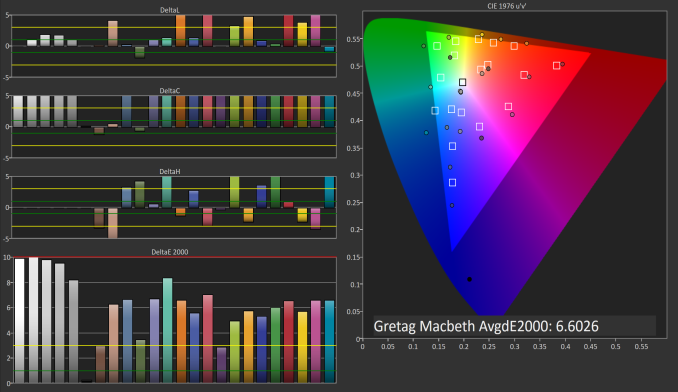








176 Comments
View All Comments
pcpoweruser - Monday, June 20, 2016 - link
You are simply not getting something - display accuracy has very little to do with sRGB color space itself. sRGB is a relatively dull, limited colorspace that defines collors far bellow what human eyes can see and it only exists because wider gamut was problematic to achieve on pre-OLED displays. AdobeRGB (that OLEDs can reach) is far richer, vibrant closer to life color space.Personally, I would never use modern, wide-gamut OLED display in crippled sRGB mode that essentially limit panel ability do render deep, saturated colours, it is just not 'fun'. Many of these colors are just UI elements, icons, etc - they look much nicer with wide gamut. Yes, I cannot believe that Android still does not have any form of color management built in and think it is a total disgrace. As a result, the cost of using full abilities of wide gamut displays is that photos (typically designed to be shown on sRGB display) will look oversaturated, even if they are embedded with proper sRGB/AdobeRGB profile, as Android simply have no way to process it. However, to be fair, I a can live with this - I am not a photographer and do not need accurate saturation in photos on my mobile.
But to the point: AdobeRGB (that many OLEDs target) is essentially extension of sRGB, so on OS that does not understand color management, photos with sRGB profile would simply look more saturated - but the colors would be still accurate (i.e certain share of red would be still the same shade, just more intense). NTSC that Oneplus 3 panel seems to target is a different gamut, that is 'shifted' in space (look at CIE graphs), so for instance orange might become red - and this is a problem.
Additionally, there is another aspect of accuracy: balance of individual primary colours at various intensity steps (so called 'greyscale') - and this is quite broken in Oneplus 3 too (yes, I have got one) - blue is dominating heavily pretty much all the intensity steps.
Combined with a very high color temperature ('balance' option in the UI does not help much, it just adds hideous pink hue) and low ~800p real resolution thanks to pentile pattern (with all the artifacts like diamond-shaped fill and color fringing at hight contrast edged) the result is simple - the display is objectively very bad.
My point of reference is to N6P panel, which is absolutely gorgeous, accurate and ultra sharp in comparison.
It is a shame, as otherwise phone is great (build quality, SoC, fast storage), but looking at the screen is just too painful for me - so I am sending it back.
I understand that possibly less than 1% really care about quality of the display, but I am one of those people and totally agree with the reviewer here.
grayson_carr - Tuesday, June 21, 2016 - link
You've missed my point entirely, which was to request that Anandtech provide measurements for displays as they are calibrated out of the box. By default, the Galaxy S7 and Nexus 6P are just as bad, calibration wise, as the OnePlus 3. They are not calibrated to any standard. Not sRGB, not Adobe RGB. Yes there are sRGB modes on both the S7 and 6P, which are what Anandtech tests and publishes results for, and there is also an Adobe RGB mode for the S7, but when you take those phones out of the box, the calibration of each is truly awful, just like the OnePlus 3. Uhg, and you're acting like the 6P has some great panel. God, the 6P screen is sharp and accurately calibrated (in sRGB mode), sure, but it has a horrible grainy look to it and has awful sunlight visibility in sRGB mode (sunlight visibility in the default inaccurate mode is fine, but it's truly terrible in sRGB mode). I own an S7 Edge, OnePlus 3, and Nexus 6P because I'm an Android app developer, so I can compare them all side by side here.pcpoweruser - Tuesday, June 21, 2016 - link
You are missing my point too: 6P in default mode is fine - it targets colour space similar to AdobeRGB, so colors are just more saturated, but they are still the same colors. There is no reason to use sRGB mode on 6P (as you mentioned it impacts maximum brightness badly - like any color curve adjustment) unless you are a photographer and work with sRGB photos on your workstation - by using sRGB mode you are simply crippling display capability to show wide gamut.Oneplus 3 is different, by default it targets odd gamut that actually shitfs colors and make them very different colors - this does not happen 6P. Not to mention terrible white balance and greyscale, which is just fine on 6P in non-sRGB mode. Grainy look on 6P display: is this a joke? Maybe with some dodgy screen protector. It is one of the sharpest, cleanest displays and makes Oneplus 3 look absolutely terrible in comparison.
grayson_carr - Wednesday, June 22, 2016 - link
"colors are just more saturated, but they are still the same colors"What? Not to me. If you take a color and make it way more saturated, it is not the same color. I guess you're saying green will still be green, etc, but just more saturated. I get that. But it still makes photos look untrue to life if the colors are all oversaturated. And even if I accept your explanation for the 6P, what about the S7 and Note 5? The default adaptive mode on those phones is NOT sRGB nor Adobe RGB. It's Samsung's made up colors that they think look good and it's no better than what we see on the OnePlus 3. If Anandtech would test these modes we would see that, which is why I want Anandtech to start testing and discussing them.
Buk Lau - Monday, June 20, 2016 - link
maybe because other so called "reviews" don't even have a colorimeter to properly test displays? subjectively saying "oh it looks good to me" doesn't mean much to everyonegrayson_carr - Monday, June 20, 2016 - link
The display is only 'bad' from a color accuracy standpoint. I actually have the phone, and also own a Galaxy S7 Edge and Nexus 5X. Subjectively, if you hand a random person on the street all three of these phones, they would probably say the OnePlus 3 display looks the best. The Nexus 5X is technically the most accurate, but looks washed out next to the other two to your average person who doesn't deal with color accurate displays for a living. The S7 Edge (mine anyways) has whites that lean too much towards green, so it looks kind of unnatural. I thought the lower resolution of OnePlus 3 would bother me because the display is pentile, but honestly, the screen density it set such that I never bring the phone close enough to my face to notice. Also, while I don't have a measurement device, I think the white balance of my OnePlus 3 is not as cool as the one Anandtech received. Comparing it to other phones, I would guess my sample is more in the 7500K range. Brandon also seems to have missed the color temperature slider in the display settings. I wonder if he had adjust the color temperature a bit warmer if the color measurements would have been a little better.grayson_carr - Monday, June 20, 2016 - link
Oh, I forgot to mention, if you like how the Galaxy S6, S7 and Note 5 displays look in their default adaptive display mode, you will probably like how the OnePlus 3 display looks because it looks very similar to that. Unfortunately, Anandtech and everyone else only test the color accuracy of Samsung displays after changing the display mode to basic / sRGB, which almost no one uses in reality. So you will hear the Galaxy S7 display is suuuupppppeeeerrrr accurate, blah, blah, blah!!! But if you go out and survey actual Galaxy S7 owners on the street, 99.9% of them will be using the default display setting that is not accurate at all and probably no more accurate than the OnePlus 3 display, yet people still say it looks great. So bottom line, don't write of the OnePlus 3 because Anandtech hates the display.Buk Lau - Tuesday, June 21, 2016 - link
it's ok, we get it, you are trying to defend your purchase. Idk if you have read any of those reviews you mentioned so far (probably not as you are still saying these), but in N6P review they clearly gave out results for both profiles. also what you are forgetting is that this is not simply a color profile issue, 1+ just straight up didn't calibrate these panels out of the box. what people like is different from what something objectively is. you can like the 1+3 and its poorly calibrated panels, but that doesn't change the fact that the panel is inaccurate. there's a reason why these standards exist, and just because you don't like the standard doesn't mean it's important.grayson_carr - Wednesday, June 22, 2016 - link
Why would I need to defend my purchase? I own a Galaxy S7 edge and will be keeping it as my main phone and returning the OnePlus 3. I only bought a OnePlus 3 because I am an Android app developer and phone enthusiast and just like trying all of the new phones. That's great that they gave out results of both profiles for the 6P, but if I remember correctly, it's only because they tested the default profile before they discovered the sRGB mode. They never test the default profile of Samsung phones. I want them to call Samsung out for shipping phones with displays that are so inaccurate out of the box. Yeah, it's great that Samsung gives you an accurate profile setting, but when you just test that and don't even mention the default profile, it confuses people and makes most people think Samsung displays are accurate right out of the box. Even many reviewers at other popular sites obviously don't know that Samsung displays are onky accurate in basic mode.grayson_carr - Wednesday, June 22, 2016 - link
there's a reason why these standards exist, and just because you don't like the standard doesn't mean it's important.Wtf dude? You've got me all wrong. I'm a proponent of sRGB. I like it and wish all phones were calibrated to that standard out of the box. That said, if you're going to completely trash a phone for not being calibrated to sRGB out of the box, you need to trash every phone that isn't calibrated to that out of the box to some extent, but Samsung just throws in an sRGB profile that no real world users even know about and gets away with shipping displays that aren't calibrated to any standard at all by default (cough... adaptive mode)???